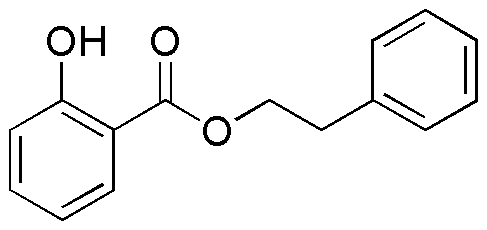Phenethyl salicylate is widely utilized in research focused on:
- Fragrance Industry: This compound is often used in perfumes and scented products due to its pleasant aroma, enhancing the overall sensory experience.
- Cosmetics: It serves as an ingredient in various skincare products, providing a soothing effect and contributing to the formulation's fragrance profile.
- Pharmaceuticals: Used in topical formulations, it can help improve skin absorption of active ingredients, making it beneficial for pain relief creams and ointments.
- Food Industry: Employed as a flavoring agent, it adds a subtle taste to food products, particularly in confections and beverages.
- Research Applications: In laboratory settings, it is utilized as a model compound for studying esterification reactions and the behavior of aromatic compounds in various chemical processes.
General Information
Properties
Safety and Regulations
Applications
Phenethyl salicylate is widely utilized in research focused on:
- Fragrance Industry: This compound is often used in perfumes and scented products due to its pleasant aroma, enhancing the overall sensory experience.
- Cosmetics: It serves as an ingredient in various skincare products, providing a soothing effect and contributing to the formulation's fragrance profile.
- Pharmaceuticals: Used in topical formulations, it can help improve skin absorption of active ingredients, making it beneficial for pain relief creams and ointments.
- Food Industry: Employed as a flavoring agent, it adds a subtle taste to food products, particularly in confections and beverages.
- Research Applications: In laboratory settings, it is utilized as a model compound for studying esterification reactions and the behavior of aromatic compounds in various chemical processes.
Documents
Safety Data Sheets (SDS)
The SDS provides comprehensive safety information on handling, storage, and disposal of the product.
Product Specification (PS)
The PS provides a comprehensive breakdown of the product’s properties, including chemical composition, physical state, purity, and storage requirements. It also details acceptable quality ranges and the product's intended applications.
Certificates of Analysis (COA)
Search for Certificates of Analysis (COA) by entering the products Lot Number. Lot and Batch Numbers can be found on a product’s label following the words ‘Lot’ or ‘Batch’.
*Catalog Number
*Lot Number
Certificates Of Origin (COO)
This COO confirms the country where the product was manufactured, and also details the materials and components used in it and whether it is derived from natural, synthetic, or other specific sources. This certificate may be required for customs, trade, and regulatory compliance.
*Catalog Number
*Lot Number
Safety Data Sheets (SDS)
The SDS provides comprehensive safety information on handling, storage, and disposal of the product.
DownloadProduct Specification (PS)
The PS provides a comprehensive breakdown of the product’s properties, including chemical composition, physical state, purity, and storage requirements. It also details acceptable quality ranges and the product's intended applications.
DownloadCertificates of Analysis (COA)
Search for Certificates of Analysis (COA) by entering the products Lot Number. Lot and Batch Numbers can be found on a product’s label following the words ‘Lot’ or ‘Batch’.
*Catalog Number
*Lot Number
Certificates Of Origin (COO)
This COO confirms the country where the product was manufactured, and also details the materials and components used in it and whether it is derived from natural, synthetic, or other specific sources. This certificate may be required for customs, trade, and regulatory compliance.


